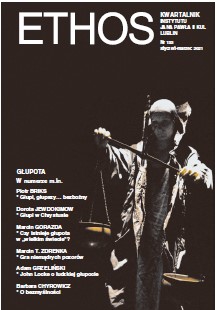BŁAZEN I HOMO STUPIDUS. O NIEKTÓRYCH ASPEKTACH WSPÓŁCZESNOŚCI
THE JESTER AND THE HOMO STUPIDUS: SOME REMARKS ON THE PRESENT TIME
Author(s): Olga PłaszczewskaSubject(s): Cultural history, Visual Arts, 16th Century, 19th Century, History of Art
Published by: Katolicki Uniwersytet Lubelski Jana Pawła II - Instytut Jana Pawła II, Wydział Filozofii
Keywords: Vittorino Andreoli; Stanisław Wyspiański; Henryk Sienkiewicz; Jan Matejko; jester; jesterhood; homo stupidus; reason; intellect; 21st-century civilization;
Summary/Abstract: The main purpose of the essay is to investigate the meaning of the figure of a jester in contemporary culture. The starting point for analysis is provided by the literary images, inspired by Jan Matejko’s paintings, of Stańczyk, the most famous Polish jester of the Renaissance (Stach Ostrożka depicted by Henryk Sienkiewicz in Potop [The Deluge] and the jester portrayed by Stanisław Wyspiański in Wesele [The Wedding]). The recognizability of those figures is interpreted as an indication that a given society succeeds in preserving their own identity. According to Vittorino Andreoli, an Italian psychiatrist and thinker, our civilization is heading for self-destruction due to the degeneration of human abilities to reason and to make connections between ideas. The figure of a jester, seen as a component of culture, remains significant as long as there is an intelligent audience, skillful in recognizing symbols, irony, and other tools used by a jester. The opposite of a jester is a modern homo stupidus who, having squandered the ability to use reason, is no longer capable of understanding his own culture and identity.
Journal: Ethos. Kwartalnik Instytutu Jana Pawła II KUL
- Issue Year: 34/2021
- Issue No: 1
- Page Range: 219-242
- Page Count: 28
- Language: Polish
- Content File-PDF

